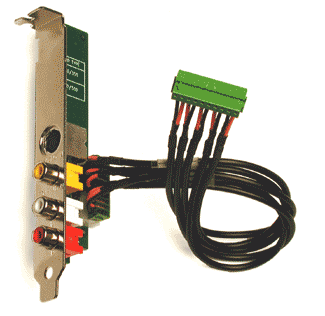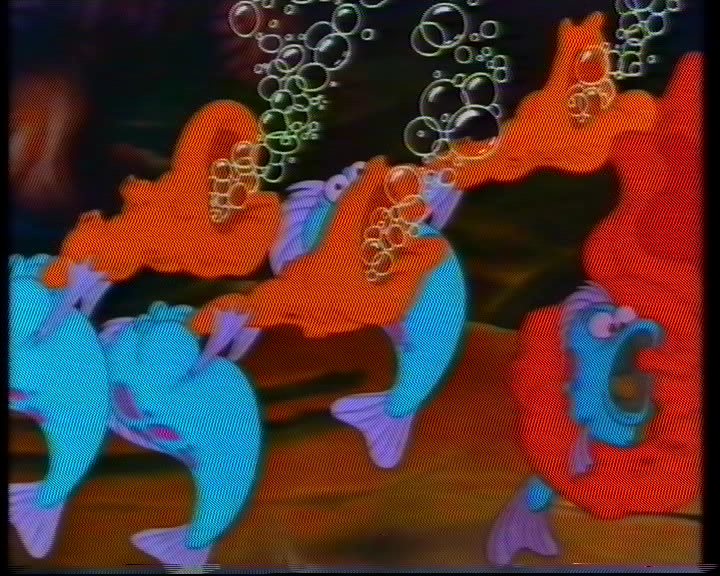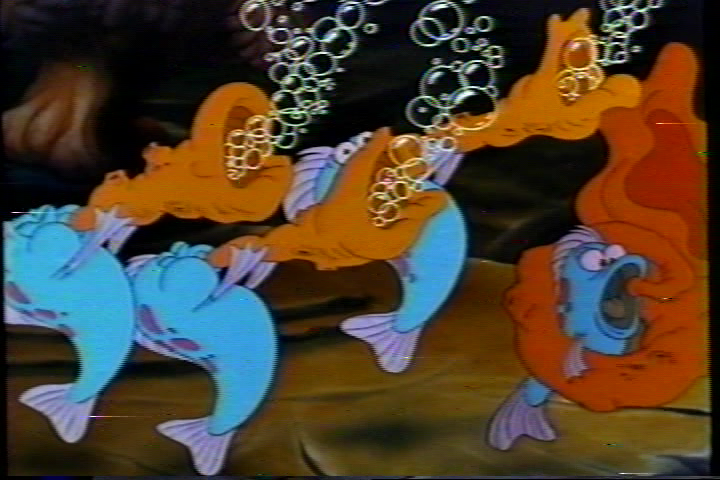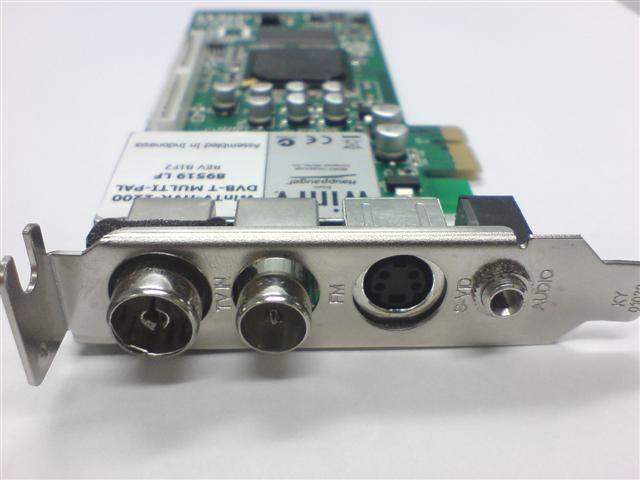Here's a sample frame from your cap and the same frame from my cap with an HVR-1250:
I didn't attempt to calibrate the 1250 at all, everything was at the default settings. My recording was at 5000 kbps VBR. I used the included composite to s-video adapter plug and had WinTV 7 set to record "composite". The adapter plug simply routes the composite signal to the s-video luma pin. The software then treats that pin as composite video. The HVR-1250 has a standard 4 pin s-video DIN connector.
+ Reply to Thread
Results 31 to 50 of 50
-
-
The top picture is showing unfiltered chroma (subcarrier) bleeding directly into luminance. This is what happens when one feeds composite into Y.
The manual should describe proper composite connections.Recommends: Kiva.org - Loans that change lives.
http://www.kiva.org/about -
wow, so many replies already. THANKS heaps, I will try my other VCR when I get back after the new year with it, as I think it might be the problem. this morning i tried some of the suggestions, the provided adapter gave a worse picture than the SVideo/composite calbe that i was using, and then trying different qualtiy settings seemed to make a difference...unitl i realised it wasn't the setting that was doing it!
it was when i stopped and played again that the picture came out better; leads me to think it's the tracking on the VCR, when i stopped and started again, the output signal was clearer and barely notice any digitizing at all!
here is a sample of video I have taken (first is origianl, second is a new copy this morning).
http://rapidshare.com/files/322804723/S-Video_20091213_1044.mpg.html
http://rapidshare.com/files/322804724/S-Video_20091219_0834.mpg.html
What do you guys think? I'm pretty happy with the improvement, so I'm eager to see how my Panasonic 6 Head VCR will do
-
Thanks again, yes, that's like the sample I recorded this morning, so much better. I don't think I changed the channel to Composite though, I haven't tried that yet...now that you mention it as an option, will do

-
I tried Composite and SVideo channels, but both did the same thing...when I was more careful pressing the Play button, it was good. When I switched channels, it went bad again and needed to stop the movie and press Play again.
I will try with my better VCR and post the results in a few weeks. Thanks again for all the help, I'm much happier with my Hauppauge hvr2200 now! -
Status Update: I connected my Panasonic HIFI VCR with the Svideo cable, and tried WinTV to view the output, and unfortunately, back to the old luma/chroma crosstalk problems again.
I tried connecting the ouptut directly to the LCD TV, and it was perfect (as good as analogue VHS will look)!
So I tried various things:
- in WinTV i tried various quality settings Best and Fair
- in WinTV I tried Svideo/Composite channel
- I tried the Svideo-composite cable and the composite cable with teh supplied Svideo converter
- I moved the VCR out of the cabinet away from as many cables and devices as possible
After all this, i still couldn't figure out what caused the problems, but sometimes the video looked good, sometimes there was crosstalk, and sometimes it had the odd little pixellation here and there...frustrating!
So from my limited knowledge, it doesn't seem to be the VCR, it's either the cable/converter or the capture card with the problem.
I compared with the old VCR, and the picture quality was better, had smoother heads and sound much better (stereo and louder).
Furthermore, can you see the tracking lines (is that what they are?) at the bottom of the sample video? they are stil there and much worse with this Panasonic...although when directly AV cables to the TV they were not present, picture was great!
Any ideas would be great, it's frustrating...
Oh, and my uncle bought a DVDREcorder/VCR combo, and he taped 1974 World Cup game and the converted DVD looked fantastic (for an analogue VHS tape)??? -
I thought we covered all this on the last page.
Are you plugging a composite VCR to this S-Video connector? That will result in crosstalk. Consult your manual for proper composite connection.
You probably need an adapter that looks like this.
Composite goes into the yellow RCA jack.
 Recommends: Kiva.org - Loans that change lives.
Recommends: Kiva.org - Loans that change lives.
http://www.kiva.org/about -
Yes, I was re-reading your comments, but I am confused as to why composite to SVideo doesn't work, as they include a converter with this unit?
I've emailed hauppauge support again about this, as they 'manual' that I have is a little brief on the topic...so I'm assuming I've done it correctly.
I guess I could try one of the A'V Brackets and see if that works, but I don't understand why they provide a converter if it's going to have this crosstalk and look crap... -
They will have to tell you.Originally Posted by gabs247Recommends: Kiva.org - Loans that change lives.
http://www.kiva.org/about -
Unfortunately, the Hauppauge support haven't told me anything useful, nor do they have any useful manuals. So this either means that it should work out of the box, or their support level is pathetic.
I was actually able to get a replacement from my supplier, but it made no difference, so it doesn't seem to be a faulty unit. Unless there is some switch that I haven't switched, or that the converter that I have isn't really good (although I tried going directly from VCR composite to LCD TV svideo and it was perfect). Apart from that, it seems that the hvr2200 doesn't do what it claims to do, or at least to an acceptable level, convert VHS to MPEG2 via Svideo
I'm getting to a point of giving up now, I was willing to try the additional AV bracket, but I've lost all confidence in the product and Hauppauge, so why would I want to buy anything else from them, when I shouldn't need to?
Any ideas/help would be appreciated, but unless someone has used this thing successfully or works at Hauppauge, I don't have much hope
cheers,
gabs -
I believe the problem stems from connection (below) during the "conversion" when you connenct the composite->svideo aux cable to the vcr. It seems that your vcr model has a poor svideo separator. And when you mix a "conversion" in-between it worsens it, as in your case, your connection route seems to be pointing in this direction:
possible cause: vcr[svideo]->svideo->composite
But, when you connect your units through both composite connections, the signal is clean.
I have the 2250, and both the composite and svideo are fine.
But this issue reminds me of the laserdisc scenario, where there are certain (most) models that have a poor svideo separator and the appropriate connector to use is the composite from the unit. On the laserdisc, the video is recorded in composite format not svideo. But, I have recently begun to wonder whether "commercial" movies are recorded (I should really say, transfered) as composite, like laserdiscs are. I only wondered that because I have noticed that most movies that I analog capture seem to transfer over composite much better than svideo, or maybe it has to do with the "subcarrier" that edDV mentioned, but that at the the commercial level, the subcarrier number or value is different than our consumer level units. It is not mentioned anywhere (that I have searched over the years) via google, how commercial movies are recorded or transfered over to vhs. That is a mystery to me to this day and quite possibly holds the secret to the optimum transfer method.
-vhelp 5351 -
thanks vhelp. i'm a bit confused though, as I have:
vcr[composite output]->composite cable->composite to svideo connector->2200[svideo input]
you seemed to have assumed the opposite from what i understand?
so i have a replacement 2200 unit, and i've tried two VCRs, the latest is a good Panasonic Stereo HIFI 6 Head VCR??? so the only thing is the composite to svideo converter, but I tried it directly from VCR to TV and it provided a fine picture. so it leads me to believe that either there is some switch on the 2200 that I need to turn on/off, or that the 2200 just doesn't have a good input filter or something that I don't understand...and that Hauppauge support don't know either, even though they apparently built the thing
correct me if I'm wrong though, as I said, I don't really understand teh problem. i think the only options are to hope someone knows if there is something I'm doing wrong, or try the external AV adapter that edTV has put a picture of???
cheers,
gabs -
I haven't dealt with PAL video capture in particular, but your samples look much worse than any chroma/luma crosstalk I've seen with NTSC. I wonder if you have something else going on? You might try capturing with Dscaler. Your card isn't in their supported card list but maybe it will work.
-
I'm sorry. I must have missed something and got confused somewhere while reading your problem vs the respones given .. w/ dialup i'm not able to review large files, so i didn't see your demos and didn't realize you solved your problem, please disregard what I said above, thanks.it was when i stopped and played again that the picture came out better; leads me to think it's the tracking on the VCR, when i stopped and started again, the output signal was clearer and barely notice any digitizing at all!
-vhelp 5352 -
Unforutnatley, my issue isn't solved. I still get what looks like tracking lines at the bottom of the video, does anyone know what could be causing this??? My VCR is all automatic, but it's not SVHS, so it's not like there are any settings that I can think I need to change.
I've tried a few more programs, I got MediaPortal to work, GBPVR and DScaler. Unfortunately, DScaler gave me an error indicating that it couldn't render the capture device signal??? Doesn't anyone know whether it might work with my 2200???
MediaPortal and GBPVR both worked, but still getting those lines at the bottom of the picture. It's a shame, as there are quite a few lines of video being affected, so it's really not good enough for me. The rest of the picture was fine though, I don't know why sometimes it seems fine sometimes it seems to pixelate a little, but the bottom lines are the big problem.
Can anyone help? Is this an issue with converting composite to svideo or is the card just rubbish? I keep being told that people use this card with set-top boxes as inputs, why do they seem to work?
cheers,
gabs -
Are you talking about the ~12 lines of noise at the bottom of the frame? You always get that with VHS. There is no way around it. That's what the deck is sending your capture card. You don't see this on TV because TV's overscan the image -- you never see the edges of the frame on TV.
-
Is that really the case? Yes, this is what I'm talking about, I didn't see those lines on the TV but I will do a test and compare outputing to the capture card and to the TV and see if it overscans those lines.
So is this noise at the bottom due to S-Video or would it happen with composite output as well? It sounds like there is no way of removing that noise then? My dad bought a DVD Recorder a few years ago, and I tried it out to see what it was like, and didn't notice any lines at the bottom of the VCR input? Do you know what causes it and why it happens for capture cards, or does it happen for the DVD Recorder as well but I didn't notice it? Unfortunately my dad lives interstate so I can't verify it happens there at the moment.
Thanks though, you've been a great help, it seems I might be chasing a white elephant here... -
That noise is due to the rotating video head. After half a turn, the drum needs to switch from the head that has reached the bottom edge of the tape to the other head which is at the top edge of the tape.So is this noise at the bottom due to S-Video or would it happen with composite output as well?
-
Some details about VHS: http://www.ronaldsnoeck.com/vcr.htm#2.
The only way to get rid of the noise is to mask or crop it.
Similar Threads
-
What Hardware/Software do I need?
By Frank W in forum Newbie / General discussionsReplies: 7Last Post: 3rd Apr 2012, 18:30 -
Hardware issues in encoding
By videobread in forum ComputerReplies: 3Last Post: 23rd Nov 2011, 10:38 -
Hardware Encoding
By jeby1980 in forum Capturing and VCRReplies: 2Last Post: 22nd Feb 2010, 00:03 -
Software or hardware encoding for project?
By stantheman1976 in forum Video ConversionReplies: 2Last Post: 11th Jun 2008, 16:53






 Quote
Quote
